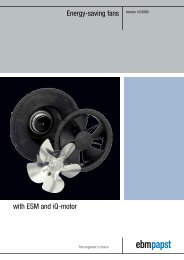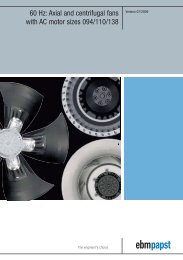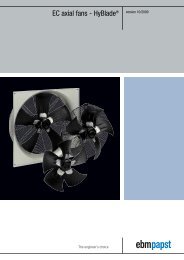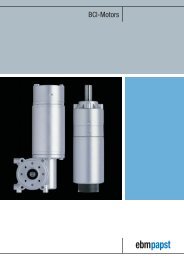Download [PDF] 2.1 MB - ebm-papst UK
Download [PDF] 2.1 MB - ebm-papst UK
Download [PDF] 2.1 MB - ebm-papst UK
Create successful ePaper yourself
Turn your PDF publications into a flip-book with our unique Google optimized e-Paper software.
fans 1 and 2 are similar. Fan 1 however requires<br />
a 30 % higher speed than the two other versions.<br />
According to [1], the total sound emission level<br />
of a fan is influenced by the internal and external<br />
turbulent flow field, the design and size of the<br />
fan as well as the rotational speed of the rotor.<br />
Fans accordingly tend to be quieter when turning<br />
at low speeds than at high speeds. For a fan to<br />
achieve the same performance at a lower speed<br />
the blades have to be designed for higher aerodynamic<br />
loads, which may adversely affect the flow<br />
field and thus the acoustic properties. In addition<br />
to the basic aerodynamic design, certain aerodynamic<br />
components of the fan are optimised for<br />
minimal sound emission to counteract this effect.<br />
Figure 2 (page 11) shows the sound power levels<br />
of fans 1 and 2 if the speed of fan 2 is altered<br />
such that it attains the same performance characteristics<br />
as fan 1 (Figure 2).<br />
The differences in the right portion of the<br />
characteristic curve amount to as much as 10 dB.<br />
The sound power spectra at the acoustically optimum<br />
point for fan 2 reveal that fan 2 has a considerably<br />
smaller blade passing frequency com-<br />
techmag 02°2013<br />
9


![Download [PDF] 2.1 MB - ebm-papst UK](https://img.yumpu.com/36174834/9/500x640/download-pdf-21-mb-ebm-papst-uk.jpg)


![Compact fans for AC and DC [PDF] - ebm-papst](https://img.yumpu.com/48610592/1/184x260/compact-fans-for-ac-and-dc-pdf-ebm-papst.jpg?quality=85)
![Download [PDF] 9.8 MB - ebm-papst Automotive & Drives](https://img.yumpu.com/47171334/1/184x260/download-pdf-98-mb-ebm-papst-automotive-drives.jpg?quality=85)

![Download [PDF] 3.1 MB - ebm-papst UK](https://img.yumpu.com/40847594/1/185x260/download-pdf-31-mb-ebm-papst-uk.jpg?quality=85)

![Download [PDF] 2.3 MB - ebm-papst UK](https://img.yumpu.com/35271378/1/190x252/download-pdf-23-mb-ebm-papst-uk.jpg?quality=85)
![Download [PDF] - ebm-papst UK](https://img.yumpu.com/35139755/1/190x135/download-pdf-ebm-papst-uk.jpg?quality=85)

![Download [PDF] 1.5 MB - ebm-papst UK](https://img.yumpu.com/30021941/1/184x260/download-pdf-15-mb-ebm-papst-uk.jpg?quality=85)
![DC fans - specials [PDF] 1.2 MB](https://img.yumpu.com/28121898/1/184x260/dc-fans-specials-pdf-12-mb.jpg?quality=85)
